By Gina Christian and Kate Scanlon
WASHINGTON (OSV News) – Catholic bishops and immigration advocates are expressing numerous concerns over a flurry of executive orders issued by newly inaugurated President Donald Trump – including one that ordered the State Department’s cancellation of all refugee travel to the U.S. by Jan. 27.
Bishop Mark J. Seitz of El Paso, Texas, chair of the U.S. Catholic bishops’ migration committee, said in a Jan. 22 statement Trump’s order was “unmerited” saying refugee resettlement is “one of the most secure legal pathways to the United States.”
He said that “national self-interest does not justify policies with consequences that are contrary to the moral law.”
Archbishop Timothy P. Broglio of the U.S. Archdiocese for the Military Services, president of the U.S. bishops’ conference, said in a statement that Trump’s executive orders on the migrants and refugees were among those the bishops found “deeply troubling.”
Kevin Appleby, senior fellow for policy and communications at the Center for Migration Studies of New York, said the U.S. “has successfully resettled refugees in the U.S. over the decades without a security breach.”
Appleby said that “to shut the door on refugee families who have already been processed, vetted, and prepared to travel is the height of cruelty.”
“The program has successfully resettled refugees in the U.S. over the decades without a security breach,” said Appleby. “There is no justified reason to halt it, other than to serve an anti-immigrant agenda.”
Category Archives: U.S. News
Briefs
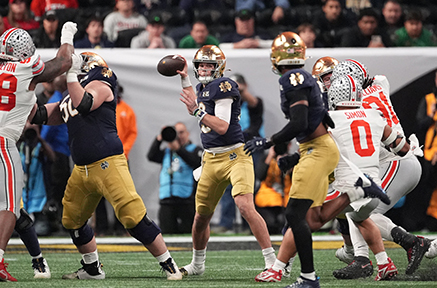
NATION
ATLANTA (OSV News) – Notre Dame’s quest for a 12th national title ended in heartbreak with a 34-23 loss to Ohio State in the College Football Playoff national championship Jan. 20 at Mercedes-Benz Stadium in Atlanta. Head coach Marcus Freeman and captains Riley Leonard and Jack Kiser faced the media with heavy hearts but praised their team’s perseverance and faith. “It’s a tough moment,” Freeman said. But of the team he said, “I’m just proud of them and proud of what they’ve done.” Leonard, who transferred from Duke for his senior year, thanked Jesus Christ and highlighted Scripture that inspired him, including Matthew 23:12 and Proverbs 27:17. He acknowledged his disappointment but credited Notre Dame’s coaches and players for shaping his journey. Kiser, reflecting on six seasons with the Irish, emphasized the program’s culture. “It’s the people that make this place different,” he said.
KEY WEST, Fla. (OSV News) – A lot has changed in the lower Florida Keys since the 1980s, when declining enrollment led to the closure of the Catholic high school in the oldest and southernmost parish of the Archdiocese of Miami. But a surge in local economic development, tourism jobs and a renewed demand for private and Catholic education in Monroe County culminated Dec. 13 in the dedication Mass and grand opening of a refurbished Basilica High School building and facility at the Basilica of St. Mary Star of the Sea Parish and School in Key West. Miami Archbishop Thomas G. Wenski presided at the dedication Mass and grand opening. The new facility will allow for full enrollment in 2025 of all four grades under the leadership of principal and president Robert Wright and will serve as an answered prayer for local parents who had few options for private education in Monroe County. The nearest Catholic high school was located in Miami-Dade County, meaning some families left the Key West area in search of a Catholic education for their children, while others settled for public education.
VATICAN
ROME (CNS) – Before the millions of pilgrims expected to come to Rome during the Holy Year 2025 cross through the Holy Door of St. Peter’s Basilica, they will be met by smiling faces and lime green jackets. Jubilee volunteers of all ages and nationalities have become a mainstay along the boulevard leading up to St. Peter’s Square since the start of the Holy Year. Wearing uniforms emblazoned with “volontario” across their backs and the Jubilee and Vatican logos on their chests, the volunteers line the pilgrims’ path, offering guidance and companionship on their spiritual journey. They escort pilgrims along the final leg of their pilgrimage to the Holy Door, checking passes, providing directions and accompanying groups in prayer. For Craig and Laura Shlattmann – a married couple of Jubilee volunteers from Tacoma, Washington – participating in the current Holy Year has been 25 years in the making. Craig was stationed in Italy for military service, and the couple lived in Rome during the Holy Year 2000. Back then they “vowed, God willing, to come back for the next ordinary Jubilee year in 2025,” Laura told Catholic News Service. After Craig’s recent retirement, the couple decided to fulfill that promise. “We returned not just for ourselves … but also to help our family, friends and everyone who comes to Rome,” Craig said Jan. 23. “It’s been a real blessing.”
VATICAN CITY (CNS) – Taking up the spirit of the recently inaugurated Holy Year 2025, the Cuban government has announced the release of 553 people currently serving prison sentences. Cuba said it would gradually release the prisoners “in the spirit of the Ordinary Jubilee of the year 2025 declared by His Holiness” following a “thorough analysis” of the legal and humanitarian avenues to enact their release, Cuba’s Ministry of Foreign Affairs announced in a statement Jan. 14. The statement did not specify who would be among the 553 prisoners designated to be released. That same day, the White House announced that it will no longer designate Cuba as a state sponsor of terrorism and that it would eliminate some restrictions on Cuba. The White House said the actions were steps “to support the Cuban people as part of an understanding with the Catholic Church under the leadership of Pope Francis and improve the livelihoods of Cubans.” Following the announcement, Cardinal Seán P. O’Malley, retired archbishop of Boston, said that for the last several years he had carried messages from Pope Francis to the presidents of the United States and Cuba “seeking the release of prisoners in Cuba and improved relationships between the two countries for the good of the Cuban people.”
WORLD
JERUSALEM (OSV News) – Catholic leaders in the Holy Land are urging Christians to return on pilgrimage to the region now that a ceasefire has been established between Israel and Hamas. In a video, the Latin patriarch, Cardinal Pierbattista Pizzaballa, and the custos of the Holy Land, Franciscan Father Francesco Patton, walk through Jerusalem, talking to pilgrims and shopkeepers who have endured streets emptied of tourists since the Oct. 7, 2023, Hamas attack on Israel and the subsequent 15-month war. The area is safe, the Holy Land church leaders stressed. Father Patton emphasized the spiritual importance of visiting holy sites. Cardinal Pizzaballa called the ceasefire a “turning point” for the Holy Land, thanking churches worldwide for their support during the challenging year. Father Gabriel Romanelli from Gaza City’s Holy Family Parish expressed hope for lasting peace, despite the ongoing challenges.
PARIS (OSV News) – After Notre Dame Cathedral’s splendid reopening, the attention of Paris Catholics turned to the nearby Church of Notre Dame de Boulogne Jan. 12 as it was solemnly elevated to the rank of minor basilica, following a decree from Pope Francis, signed June 29. The Jan. 12 elevation ceremony was presided over by Bishop Matthieu Rougé of Nanterre, along with the apostolic nuncio to France, Archbishop Celestino Migliore. Located in the town of Boulogne-Billancourt, Notre Dame de Boulogne has deep historical roots, dating back to 1319 when French King Philip IV founded it to replicate a pilgrimage site in northern France. Over 700 years later, the church is still a center of faith in the region. Bishop Rougé said reviving its spiritual mission is important, especially because it is located in a major economic hub of the Paris metro area. The church’s rich architecture blends Gothic and 19th-century styles, and the church itself is a popular place of devotion for locals and visitors alike. Bishop Rougé hopes its new basilica title will invigorate evangelization efforts and provide spiritual hope in an increasingly secular society. Notre Dame de Boulogne is now the 176th basilica in France.
Fire captain makes way through ruins of incinerated church to find tabernacle intact
By Maria Wiering
LOS ANGELES (OSV News) – Four days after Corpus Christi Church was incinerated in the Palisades Fire, Capt. Bryan Nassour of the Los Angeles Fire Department picked his way over a 6-foot layer of rubble in the ashen bones of the sanctuary and recovered the tabernacle Jan. 11.
“I did it because the whole community has been decimated – it looks like a nuclear bomb has gone off and nothing is standing,” Nassour told Angelus, the news outlet of the Los Angeles Archdiocese. Nassour’s family belongs to St. Francis de Sales Church in Sherman Oaks, and his brother belongs to Corpus Christi.
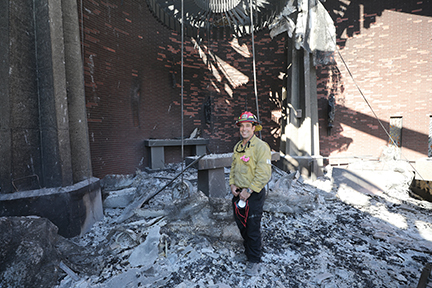
“My brother lost his home. I have close friends who lost everything but the shirts on their backs, and they belong to that church too. So, if I could save just one thing, let it be this, so they have something to believe in,” he said.
That Saturday morning Nassour, whose station in Pacific Palisades is across the street from Corpus Christi, had been up all night battling other fires. As he sipped coffee at his desk and gazed at the ruined church, he decided to check for valuables. He wanted to protect them from looters and perhaps return something meaningful to the parish.
Scorched bricks, tiles and hunks of debris filled the nave so high that he had to crawl under the top of door frames that no longer had doors. The roof had collapsed, a burned steel frame teetered above the twisted remains of a chandelier. The pews had been consumed. Only the granite altar remained, with the solid brass tabernacle atop it and a cross above. The Blessed Sacrament was intact.
Nassour was astounded to find that the tabernacle weighed more than 300 lbs. His crew helped him get it into the station house.
“It was one of the most uplifting things,” he said. “Not everyone is religious, but they saw that and they’re like, ‘This is awesome.’ We’re doing something – at least one thing – that we can salvage for the community.”
He made many calls before he was able to reach Msgr. Liam Kidney of Corpus Christi to tell him that the tabernacle was safe and undamaged.
“He was in utter disbelief,” Nassour said.
Nassour offered to search for other sacred objects and the priest told him where to find the chalices and patens. Firefighters from Station 69 helped dig for the crushed cabinet. The chalices and patens had been severely damaged. But the firefighters recovered other sacred objects, including three unbroken containers of holy oil.
Brass withstands high heat, but Nassour suspects more was involved in the tabernacle’s survival.
“Talk to any firefighter. In any religious building what usually survives is the cross and certain specific items that are highly religious, unless they’ve been specifically set on fire,” he said.
Gabe Sanchez, a retired FBI special agent who does contract investigations for the Los Angeles Archdiocese, was sent to retrieve the tabernacle. Firefighters helped him wrestle it into his car. He drove it to St. Monica Church, where Msgr. Kidney celebrated Mass for survivors the next day.
At that Mass, the tabernacle stood on a table by the altar. Msgr. Kidney recounted Nassour calling him to ask, “I have found this big gold box. What would you like me to do with it?”
The Corpus Christi parishioners burst into applause.
Nassour was unable to attend because he was fighting fires.
(Ann Rodgers writes for Angelus, the news outlet of the Archdiocese of Los Angeles.)
Report: 20 years of data shows clerical abuse allegations down in US
By Gina Christian
(OSV News) – A new report confirms OSV News’ previous finding that U.S. Catholic dioceses and eparchies have paid more than $5 billion to settle abuse claims filed over the past two decades — but credible allegations have declined significantly over the same period, with the majority of cases preceding a landmark set of anti-abuse protocols established by the U.S. bishops in 2002.
Catholic dioceses, eparchies and parishes in the U.S. have “changed how they do things” in terms of addressing and preventing abuse, said Jonathan L. Wiggins, sociologist and director of parish surveys at the Center for Applied Research in the Apostolate at Georgetown University.
On Jan. 15, CARA – which conducts social scientific studies on the Catholic Church — released a 20-year summary of annual data for the U.S. Conference of Catholic Bishops’ yearly report on the implementation of the “Charter for the Protection of Children and Young People.”
The document – adopted by the USCCB in 2002, and commonly called the Dallas Charter — lays out a comprehensive set of procedures for addressing allegations of sexual abuse of minors by Catholic clergy. The charter also includes guidelines for reconciliation, healing, accountability and prevention of abuse.
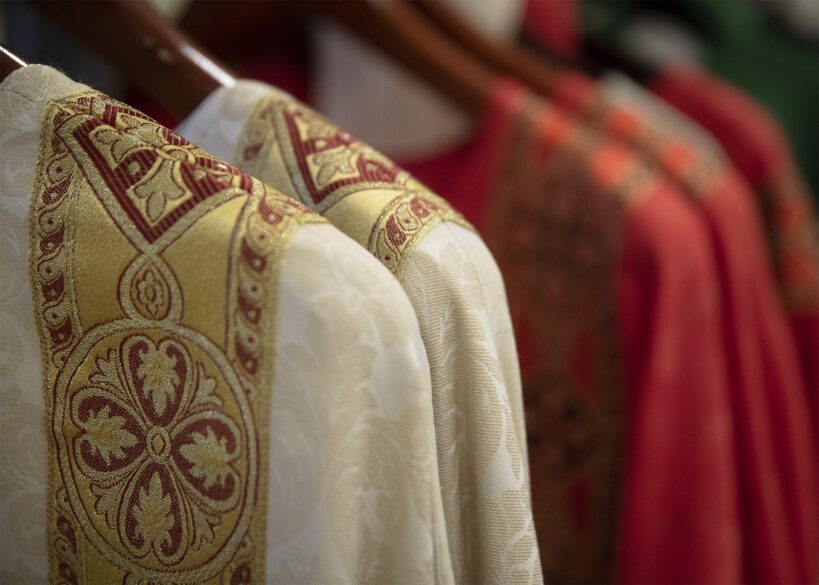
CARA’s two-decade review of the numbers indicates that the charter is working, and that the Catholic Church in the U.S. is making real progress in eradicating the scourge of clerical abuse, said Wiggins.
Since 2004, CARA has collected and prepared data for the USCCB on the charter’s implementation, using both web-based and mail-in surveys.
The CARA surveys complement the annual audit of dioceses and eparchies conducted by a USCCB-commissioned third-party firm, which since 2011 has been StoneBridge Business Partners, a Rochester, New York-based consulting firm that provides forensic and compliance services to a range of organizations. (Religious communities of men do not participate in the Dallas Charter audit process, but many instead seek separate accreditation for commonly accepted abuse prevention and protocols.)
Response rates for CARA’s voluntary annual surveys have averaged 99% for dioceses and eparchies and 72% for religious communities of men, according to the CARA summary report. Wiggins noted to OSV News that the Conference of Major Superiors of Men has “worked very hard to encourage their members to participate” in the annual CARA surveys, but stressed that the conference was a “voluntary collective” that could not compel such participation.
Catholic dioceses and parishes in the U.S. have “completely reformed how they recruit people, how they report,” Wiggins said. “They’ve made a public invitation to bring allegations (forward). They do background checks on everyone, not just at the diocesan level but in parishes. They train people about sex abuse.”
According to the report, dioceses, eparchies and religious communities spent a total of almost $728 million over the past 20 years in safe environment salaries, training programs and background checks. Those costs increased 80% over the span of the report period.
Wiggins described the shift in approach as “quite amazing” – and a “story that doesn’t get out” unless the data is viewed longitudinally, and in a national context, rather than simply through media coverage of a given diocesan abuse settlement.
“Sometimes the headlines make it sound like everyone’s having a whole lot of allegations all the time,” he said.
For the period 2004-2023, a total of 16,276 allegations of minors by priests, deacons and religious were deemed credible by dioceses, eparchies and religious communities in the U.S. — 82% by dioceses and eparchies, and 18% by religious orders.
An allegation, defined as “one victim alleging an act or acts of abuse by one alleged perpetrator,” can represent “a single assault or for a series of assaults on a single victim over many years,” the report said.
But, CARA stressed, “to be clear, these credible allegations of abusive behaviors did not occur over the 20 years of the survey, but rather over the more than 80 years asked about on the annual surveys.”
During the 20-year survey period, said the report, “a majority of dioceses, eparchies, and religious communities of men did not have a credible allegation, with an average of three in five (60%) having no allegations in a particular survey year.”
The summary report said that “more than nine in ten of all credible allegations occurred or began in 1989 or earlier (92%), 5% occurred or began in the 1990s, and 3% occurred or began since the year 2000.”
Most of the alleged perpetrators – 86% – “were identified as ‘deceased, already removed from ministry, already laicized, or missing,'” said the report.
That figure is “not surprising,” said CARA in its Jan. 15 media release, “as about seven-tenths (72%) of the alleged abuses occurred in 1979 or earlier, 20 to 50 years before the first CARA survey was conducted in 2004.”
The other 14% were “permanently removed from ministry or retired from ministry during the year” of that particular survey, said the report.
The report also found that 95% of the alleged abusers were priests, with 80% diocesan and 15% religious, while 4% were religious brothers and 1% were diocesan or religious deacons.
The majority of abuse victims (80%) were male, and over half (56%) were ages 10-14 at the start of the abuse, with 24% ages 15-17 and 20% age 9 or less.
The report did not speculate on possible factors behind the demographics of alleged abusers and their victims, and Wiggins told OSV News such considerations were beyond the scope of study.
However, according to research cited by RAINN (Rape, Abuse and Incest National Network), which operates the National Sexual Assault Hotline (800-656-HOPE), a majority of child abuse perpetrators (88%) are male.
Wiggins also highlighted the methodological adaptations he and his fellow researchers have had to make over the years as the clerical abuse scandals have unfolded.
One such adaptation was the 2016 addition of a new survey classification for claims: “unable to be proven.”
While “credible” and “unsubstantiated” allegations are deemed as such based on evidence gathered through an investigation, CARA began listing the “unable to be proven” category to capture those claims for which “limited information was known and a thorough preliminary investigation was unable to occur.” The reasons for the lack of information include: deceased parties in a given allegation, as well as restrictions due to court actions and state investigations.
In all three categories – credible, unsubstantiated and unable to be proven — claims may or may not have been paid out in a settlement, the report noted.
With the addition of the “unable to be proven” category in 2016, “the proportion of allegations deemed credible by dioceses, eparchies, and religious communities of men has decreased from 82% to 54%,” said the report.
At the same time, Wiggins cautioned that there is generally a considerable span of time between the commission of abuse and its actual disclosure – a gap that could impact future data.
Regarding the 3% of credible allegations since 2000, Wiggins said that incidents of abuse “happening right now may not come to light for another decade or so. We can’t say, ‘Oh, only 3% are happening now.’ We can only say, ‘Only 3% are being reported now.'”
While continued vigilance against abuse will remain crucial, Wiggins expressed optimism about the progress made so far.
“It’s not easy for an organization like the Catholic Church to make a big change, (but) they’ve really changed how they do things, fundamentally,” he said. “And of course they couldn’t turn on a dime, but they really have made the changes.”
Gina Christian is a multimedia reporter for OSV News. Follow her on X @GinaJesseReina.
Archbishop Broglio: MLK challenges all to ‘live out’ solidarity, human dignity
By Gina Christian
(OSV News) – The words of slain civil rights leader Rev. Dr. Martin Luther King Jr. continue to challenge all “to live out the principle of solidarity and human dignity,” said the president of the U.S. Conference of Catholic bishops.
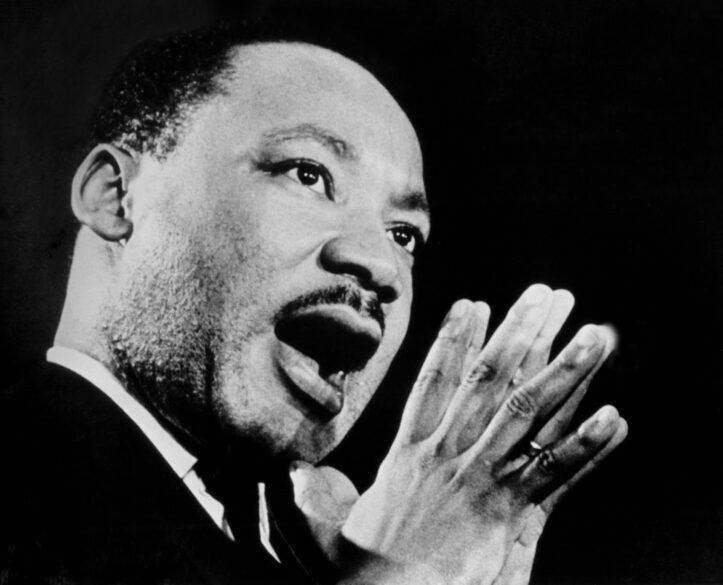
Archbishop Timothy P. Broglio of the U.S. Archdiocese for the Military Services reflected on Rev. King’s legacy in a Jan. 10 statement ahead of the Martin Luther King Jr. federal holiday, which is observed on the third Monday of January and which this year is Jan. 20.
The commemoration was created after a 32-year-campaign to nationally recognize the life and work of Rev. King, a Baptist minister and Nobel Peace Prize winner who spearheaded the U.S. civil rights movement from the mid-1950s until his assassination in 1968. He was just 39 years old.
Profoundly influenced by the nonviolent approach of Indian activist Mahatma Gandhi, Rev. King led campaigns to end legal segregation of Black Americans in the U.S. in the face of at-times violent opposition.
Among the most celebrated of these efforts were the 1955-1956 Montgomery, Alabama, bus boycott; the 1963 March on Washington, which drew more than 200,000 demonstrators; and the 1965 march from Selma, Alabama, to that state’s capital in Montgomery.
Rev. King’s sermons, speeches and texts drew on his extensive theological training, and Archbishop Broglio opened his Jan. 9 statement with a quote from “Letter from a Birmingham Jail,” which Rev. King wrote following his April 1963 arrest for violating an Alabama law against mass public demonstrations.
In the letter, Rev. King responded to fellow clergy members’ criticism of the civil rights campaign, declaring, “Injustice anywhere is a threat to justice everywhere.”
“In reflecting on the continuing realities of racial injustice, immigrant families seeking welcome, and economic disparity, these words remind us that we are connected and responsible for each other as we seek to fulfill the dream,” said Archbishop Broglio in his statement.
The archbishop also cited Pope Francis’ address to Congress during a 2015 apostolic visit to the U.S., in which the pope recalled King’s 1965 Selma-Montgomery march.
Echoing Rev. King’s 1963 “I Have a Dream” address in Washington, Pope Francis described the Selma-Montgomery march as part of King’s “campaign to fulfill his ‘dream’ of full civil and political rights for African Americans.”
“That dream continues to inspire us all,” the pope told Congress in 2015. “I am happy that America continues to be, for many, a land of ‘dreams.’ Dreams which lead to action, to participation, to commitment. Dreams which awaken what is deepest and truest in the life of a people.”
“Let us be inspired by this righteous man’s work and sacrifice to create a more just society for all of God’s children,” said Archbishop Broglio.
(Gina Christian is a multimedia reporter for OSV News. Follow her on X @GinaJesseReina.)
(Editor’s note: See reflections from two local Catholics on how Dr. King’s message impacted their lives.)
New Orleans archbishop, others offer prayer and support for victims of ‘evil’ deadly New Year attack; FBI investigating as terrorism
By OSV News
Archbishop Gregory M. Aymond of New Orleans offered prayers for victims of what he described as a “sign of utter disrespect for human life” perpetrated by a man who drove a Ford pickup truck through crowds celebrating the New Year in New Orleans’ French Quarter around 3:15 a.m. Jan. 1. At least 15 people were reportedly killed, with around 35 others injured.
The driver was killed by police after leaving the vehicle and exchanging gunfire with law enforcement, striking two officers. The FBI is investigating the attack as an act of terrorism.
“Our prayers go out to those killed and injured in this morning’s horrific attack on Bourbon Street,” said Archbishop Aymond, a New Orleans native, in a Jan. 1 statement. “This violent act is a sign of utter disrespect for human life. I join with others in the Roman Catholic Archdiocese of New Orleans in offering prayerful support to the victims’ families. I give thanks for the heroic duty of hundreds of law enforcement and medical personnel in the face of such evil.”
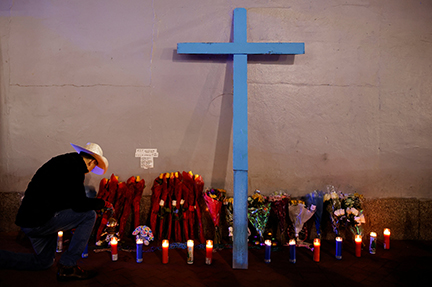
Officials identified the driver as Shamsud-Din Jabbar, and said he likely did not act alone. An ISIS flag was located on the vehicle’s trailer hitch. The FBI found explosive devices in the pickup truck and elsewhere in the French Quarter, including reportedly near the historic Cathedral Basilica of St. Louis.
In an early afternoon press conference, officials described Jabbar, 42, as “a U.S.-born citizen from Texas” and U.S. Army veteran, and that law enforcement is looking for known associates. Anyone who had interacted with Jabbar within 72 hours prior to the attack is asked to contact the FBI at the agency’s tip line, 1-800-CALL-FBI.
New Orleans Police Superintendent Anne Kirkpatrick and other city officials confirmed that the attack was deliberate and that they were focused on ensuring the safety of the city’s residents and visitors. Officials did not release information about the identities of the victims known dead. A few hours later, authorities updated the death count from 10 to 15.
Louisiana Attorney General Liz Murrill said during the press conference that there were “some people who are fighting for their lives right now in the hospital.”
“So I’d ask everyone to pray for them,” she said. “They need our support and they need our prayers.
“This was a heinous act. A heinous, cowardly act,” she added. “And we will find them and we will bring them to justice.”
At the press conference, Louisiana Gov. Jeff Landry announced he had issued an amended emergency declaration so “that we could bring all of our federal, state, and local agencies to bear in preparation for the Super Bowl and Mardi Gras.” Because of the attack, Landry said he also ordered “the mobilization of a military police company” in New Orleans.
Also speaking at the press conference, U.S. Sen. John Kennedy said, “I wish I understood better why bad things happen to good people.”
“If I make it to heaven, I’m going to ask,” he said. “For those people who don’t believe in objective evil, all you have to do is look at what happened in our city early this morning. If this doesn’t trigger the gag reflex of every American, every fair-minded American, I’ll be very surprised.”
Kirkpatrick, whose role includes chief of police, called the action “evil” and that “New Orleans Police and all law enforcement is built, we are built, for dealing with evil.”
President Joe Biden said in a statement that he was “grateful for the brave and swift response of local law enforcement in preventing even greater death and injury.”
“I have directed my team to ensure every resource is available as federal, state, and local law enforcement work assiduously to get to the bottom of what happened as quickly as possible and to ensure that there is no remaining threat of any kind,” he said.
University of Notre Dame president Father Robert Dowd, a priest of the Congregation of Holy Cross, shared a message on a website for Notre Dame alumni and friends and on X, where he said the university community extends “our deepest gratitude to the brave first responders who risked their lives to protect others.”
“To be in solidarity with those who suffer is to exemplify the spirit of Notre Dame,” he wrote. “Today, we are in solidarity with all those impacted by this tragedy.”
Saying that it is “always grounded in faith, hope, and love, especially at difficult times,” the Cathedral Basilica of St. Louis posted on social media the archdiocese’s “Family Prayer” requesting the intercession of Mary under the title of “Our Lady of Prompt Succor.” It noted that the church “serves the entire Archdiocese and far beyond, but the French Quarter is our home and neighborhood.”
“We stand in solidarity with those who lost loved ones this morning,” it said. “We are grateful for the first responders and other healthcare and law enforcement professionals who put themselves in harm’s way and who care for the injured.”
The attack occurred on the solemnity of Mary, Mother of God, and the World Day of Peace.
Washington’s new archbishop seeks to ‘know and understand this magnificent community of faith’
By Richard Szczepanowski
WASHINGTON (OSV News) – Hours after Cardinal Robert W. McElroy of San Diego was announced Jan. 6 as the new archbishop of Washington, the prelate praised his new archdiocese as “truly sacramental in the rich diversity of its traditions and perspectives.”
He also pledged to “show reverence for the grace of God which is already present in your midst and in the commitment to discipleship that underlies this local church.”
“I come as your bishop seeking to know and understand this magnificent community of faith,” Cardinal McElroy said. “As your pastor, an essential element of my mission is to encounter the hearts and the souls of the disciples who form our local church.”
In a virtual news conference at the Cathedral of St. Matthew the Apostle in Washington, Cardinal McElroy addressed his new flock via the Archdiocese of Washington’s YouTube channel because a major snowstorm shut down the city.
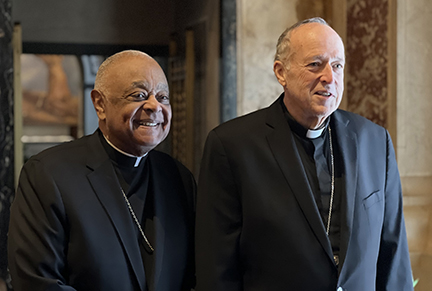
“I want to give thanks to God for the grace-filled life of this local church and to Our Holy Father, Pope Francis who today makes me a member of that church,” Cardinal McElroy said.
Early Jan. 6, Pope Francis accepted the resignation of Cardinal Wilton D. Gregory, Washington’s archbishop since 2019, and named the San Diego prelate as his successor. As required by church law, Cardinal Gregory had submitted his resignation to the pope when he turned 75, which was two years ago, on Dec. 7, 2022.
The new archbishop of Washington said he has embraced Pope Francis’ emphasis on synodality and its call for the faithful to “build up a church centered in the Eucharist and devoted to the Word of God and the sacraments which sustain us.”
“Synodality calls us to walk humbly as a church, acknowledging our faults and sinfulness, and seeking forgiveness,” said Cardinal McElroy, who is 70. “It seeks the participation of every disciple in the church’s journey in this earthly pilgrimage, and is oriented toward the building of unity in society rooted in God’s justice, which cares especially for the unborn, the poor, the marginalized and the dispossessed.”
He said that in the Archdiocese of Washington, “for the past 85 years, the Catholic community has radiated the light of Christ throughout the District of Columbia and the surrounding five counties in Maryland.”
The archdiocese is home to more than 671,000 Catholics in D.C. and Maryland’s Montgomery, Prince George’s, St. Mary’s, Calvert and Charles counties.
Cardinal McElroy praised the archdiocese for its “rich parish communities of faith” and its “path-breaking development of lay ministries and apostolates, and the nurturing in lay leadership in the church that is genuinely participative and inclusive.”
The people of his new archdiocese, the cardinal said, are “men and women who form the people of God, struggling in a world filled with turbulence, hardship and illusion, to follow the pathway of Jesus Christ … (and are) called to be both dispensers and receivers of mercy and forgiveness.”
He noted that the Archdiocese of Washington has experienced “mountain-top moments” such as the visits of St. John Paul II, Pope Benedict XVI and Pope Francis and has endured “moments of failure and shame,” including reports of the sexual abuse of minors.
“In this mixture of the mountain top and failure, we are no different from the first disciples of the Lord,” Cardinal McElroy said. “It is to this community on the journey of faith that the Holy Father has called me to be bishop and pastor.”
Cardinal McElroy said Cardinal Gregory – appointed by Pope Francis in 2019 as the seventh archbishop of Washington and elevated to the College of Cardinals the following year – displayed “courage, a deeply pastoral heart and abiding faith in God and the dignity of the human person” as he “made critically important contributions at crucial moments in order to bring the Gospel of Jesus to the heart and the soul of the Catholic community here in Washington.”
At the Jan. 6 conference, Cardinal Gregory said, “As I reflect upon the past nearly six years in this wonderful local church of Washington, my heart is filled predominantly with joy and gratitude for the many blessings, always appreciated but rarely deserved that God has granted me.”
He thanked the priests, auxiliary bishops and the faithful, noting that “we have loved one another, cared for one another, challenged one another to be the Catholic Church Jesus Christ calls us to be.”
Cardinal Gregory said that he plans to remain in Washington after his retirement and serve where needed.
(Richard Szczepanowski is managing editor of the Catholic Standard, newspaper of the Archdiocese of Washington.)
What does the church teach about immigration and deportation?
The Catechism of the Catholic Church instructs, “The more prosperous nations are obliged, to the extent they are able, to welcome the foreigner in search of the security and the means of livelihood which he cannot find in his country of origin.”
At the same time, the church has also made clear human laws are also subject to divine limits. St. John Paul II’s 1993 encyclical “Veritatis Splendor” (“Splendor of Truth”) and 1995 encyclical “Evangelium Vitae” (“The Gospel of Life”) both quote the Second Vatican Council’s teaching in “Gaudium et Spes,” the Pastoral Constitution on the Church in the Modern World, which names “deportation” among various specific acts “offensive to human dignity” that “are a disgrace, and so long as they infect human civilization they contaminate those who inflict them more than those who suffer injustice, and they are a negation of the honor due to the Creator.”
The late pontiff underscored their moral severity in “Veritatis Splendor” by calling them examples of “intrinsic evil,” explaining that, no matter the motives, these acts are “not capable of being ordered to God and to the good of the person.”
Migrants in US programs highly vulnerable to mass deportation push
By Kimberley Heatherington
(OSV News) – Since President-elect Donald Trump’s Nov. 5 victory, most Americans expect him to tackle the issue of immigration within the first 100 days of reoccupying the Oval Office.
But will immigrants who registered with the federal government – hoping for a path to citizenship through programs such as Keeping Families Together (KFT), Consideration of Deferred Action for Childhood Arrivals (DACA), and Temporary Protected Status (TPS) – actually be the most vulnerable to deportation?
The answer may hinge both on whether the information provided to the Department of Homeland Security will be used for deportation purposes – and how quickly the Trump administration wants to deliver results on its mass deportation pledge.
When it comes to migrants’ information with DHS, in the past, “there has been a firewall between those who might have provided information because of a benefit they were seeking, and that information being used for enforcement purposes,” explained J. Kevin Appleby, senior director of International Migration Policy at the Center for Migration Studies of New York and former migration policy director for the U.S. Conference of Catholic Bishops.
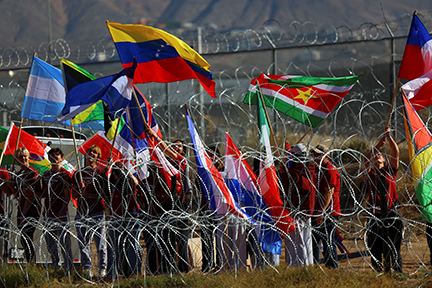
This time, he said, “all bets are off. They’ll have access to that information, so they could use it to track potential beneficiaries.”
On Nov. 7, U.S. District Judge J. Campbell Barker of the Eastern District of Texas struck down the KFT program – rolled out in June – arguing the Biden administration exceeded its authority. KFT allowed U.S. citizens’ spouses and stepchildren, who lacked legal immigration status but lived in the U.S. for 10 years or more, to apply for permanent residency without first having to leave the country.
Approximately 500,000 spouses of U.S. citizens and 50,000 noncitizen children under 21 with a parent married to a U.S. citizen were eligible for the program.
DACA allows approximately 535,000 young immigrants brought to the U.S. without authorization as children, to seek temporary protection from deportation. The program, which began in 2012 under the Obama administration, also allows them to work legally. Trump attempted to end DACA in 2017, but the Supreme Court upheld the program in 2020.
TPS is a program for people from countries experiencing such extreme internal disruption that their deportation would be considered unsafe, or even life-threatening. TPS recipients have legal authorization to work and remain in the U.S. while their countries of origin retain that designation. The program garnered widespread media attention this fall after false reports of immigrants eating pets in Springfield, Ohio, exploded on social media during the U.S. presidential campaign. However, there was underlying friction between some of the town’s native residents and thousands of Haitian recipients of TPS legally living and working there.
Those migrants with legal immigration status are not necessarily safe, said Appleby.
“It’s basically an executive authority that provided them that legal status. So the new executive, he can revoke it,” Appleby said.
Trump and Vice President-elect JD Vance both strongly suggested on the campaign trail that TPS, which currently protects 1 million people, will be curtailed in their administration. Trump himself pledged in October to revoke TPS for the Haitians living in Springfield and who are credited with fueling the Rust Belt city’s economic revitalization.
Erin Corcoran, executive director of the Kroc Institute for International Peace Studies and a faculty fellow at the Klau Institute for Civil and Human Rights at the University of Notre Dame, shared Appleby’s concerns regarding Trump’s mass deportation plans for an estimated 11 million people.
During his first term, President Trump deported 1.5 million people – a number President Joe Biden matched in 2024 – compared to 4.8 million during President Barack Obama’s two terms, according to data tracked by the Migration Policy Institute.
“If they want to do it really quickly – if they want to effectuate it immediately – the people that are going to be the most at risk,” Corcoran said, “are the people that actually have come in contact already with the authorities. The people who don’t have actual status – but who have come in contact with DHS in some way – I think are at risk of deportation.”
Which perhaps seems contradictory, Corcoran said.
“Those are in some ways the most sympathetic groups of people. From a moral perspective, from a humanitarian perspective, those are people who actually have done what they’re supposed to do,” she said. “They’ve come forward, they’ve given information; they’re in the system.”
And unlike most unauthorized immigrants, they’re easily located by authorities.
“These people who have registered – families – they have names; they have addresses,” Corcoran said.
Trump’s new “border czar” Tom Homan, who was named to the role Nov. 10 and will not require Senate confirmation, has repeatedly addressed the question of mass deportation’s effects on families. Homan was Trump’s acting director of Immigration and Customs Enforcement during the 2017-2018 “zero tolerance” era that witnessed children taken from their parents in the midst of illegal border crossings.
In response to whether mass deportation can be conducted without separating families, Homan told CBS’ “60 Minutes” in October, “Of course there is – families can be deported together.”
On Dec. 26, Homan told multiple media outlets that the incoming Trump administration is considering open-air family detention centers for holding and deporting families. He said parents facing deportation will have to decide whether their U.S.-born children will come with them, or remain in the U.S. with a relative. He offered the following justification: “You knew you were in the country illegally and chose to have a child. So you put your family in that position.”
Pedro Alemán Perfecto, a policy advocate at the Catholic Legal Immigration Network Inc., also known as CLINIC, acknowledged Homan’s pledge to come after migrants with greater force. But he kept a measured outlook, noting that migrant advocates have also been preparing.
“It’s not about panicking the community or individuals. It’s being cautious – but vigilant – about this,” he said. “That’s what our community and vulnerable immigrant communities are feeling right now: They’re looking at who can be leading us; who can be working with us. And it’s knowing what’s going to happen in the next four years for them.”
Advocacy tactics, said Alemán, will likely need to adapt.
“At CLINIC, we strive to put a lot of information out there in the community, to combat misinformation and disinformation,” he said. “For us, it’s doing our research; doing our advocacy; knowing who we can trust with different partners – and then reaching out to impacted individuals on the ground.”
The destination of mass deportees also remains an open question. They may not even end up in their countries of origin.
NBC News reported Dec. 5 the incoming Trump administration is assembling a list of potential countries to ship migrants to if their home nations refuse to accept them. The Bahamas stated it had “reviewed and firmly rejected” the Trump plan, while NBC’s sources said other countries under consideration include Turks and Caicos, Panama, and Grenada.
In an NBC “Meet the Press” interview broadcast Dec. 8, Trump echoed many of Homan’s comments, noting his deportation agenda will focus on those with criminal histories – while also vaguely referring to “other people outside of criminals.”
He also reinforced his pledge to end birthright citizenship, while saying he was open to working with Democrats to devise a plan concerning “the Dreamers,” or DACA recipients.
At the U.S. bishops’ general meeting in November, Bishop Mark J. Seitz of El Paso, Texas, the bishops’ migration committee chair, said the bishops are “waiting to see just exactly what takes shape.” But he promised they will “raise our voice loudly,” if Trump’s deportation rhetoric becomes a reality.
Reports indicate not only that the incoming Trump administration’s mass deportation policy will be ready to launch Day 1 – it will run headlong into the life of the church.
On Dec. 11, NBC News reported Trump’s incoming administration plans to rescind a long-standing “sensitive locations policy” previously prohibiting the arrest of unauthorized migrants – except under certain circumstances – at churches, schools, and hospitals.
Appleby said the U.S. bishops are facing a critical moment that will “test the resolve of the church.” While statements of solidarity are helpful, Appleby said plans for direct action – including direct support and legal assistance to immigrant families – are required.
“If Trump fully implements this,” Appleby predicted, “it’s going to impact the life of the church. You’re going to have ICE agents outside the Mass door. You certainly will see some immigrants seek sanctuary in their parishes. And it will put the bishops in a difficult position with the government.”
“We have a pope who is a strong defender of migrants,” Appleby said. “And hopefully, the U.S. church will reflect that in their response to this massive deportation plan.”
(Kimberley Heatherington writes for OSV News from Virginia.)
Day of Prayer for the Legal Protection of Unborn Children: January 22
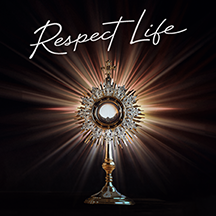
The over 60 million abortions since the 1973 decisions of Roe v. Wade and Doe v. Bolton reflect with heartbreaking magnitude what Pope Francis means by a “throwaway culture.” However, we have great trust in God’s providence. We are reminded time and again in Scripture to seek the Lord’s help, and as people of faith, we believe that our prayers are heard.
And while, on June 24, 2022, the Dobbs v. Jackson Women’s Health Organization decision overturned Roe v. Wade, right now state and federal laws, in many instances, are still hostile to preborn children. So, great prayer and advocacy is still very needed.
The General Instruction of the Roman Missal, no. 373, designates January 22 as a particular day of prayer and penance, called the “Day of Prayer for the Legal Protection of Unborn Children”: “In all the Dioceses of the United States of America, January 22 (or January 23, when January 22 falls on a Sunday) shall be observed as a particular day of prayer for the full restoration of the legal guarantee of the right to life and of penance for violations to the dignity of the human person committed through acts of abortion.”
